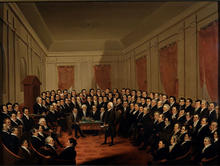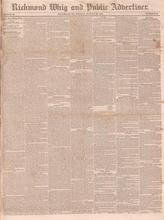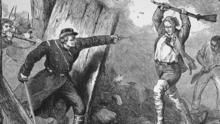Partisan Politics in Virginia, 1819-1859
by Ian Iverson
Virginia’s first constitution, drafted shortly after Congress declared independence in 1776, reflected the philosophy, demography, and political economy of the late eighteenth century. Suspicious of both centralized authority and the mass of ordinary people, Virginia’s republican planters apportioned representation on a county basis to favor slaveholding eastern planters and insisted on limiting the suffrage to white-men who owned at least 50-acres— a policy which disenfranchised about 50 percent of adult while men in addition to all women and people of color. The legislature elected all major statewide officials, including the governor, who remained beholden to the legislature throughout his tenure.
By the 1820s and 1830s, however, many states had begun to amend their constitutions to expand the franchise to all adult white men. This period marked an ideological shift away from the classical republicanism characteristic of the founding fathers towards the popular democracy of Andrew Jackson. While classical republicans agreed that sovereignty resided with the public, they believed that only men with the wealth and formal education necessary to cultivate disinterested virtue could be trusted to vote or hold office. Once elected, officials were to act as the public’s trustees, making decisions for their constituents rather than on relying on their input. For popular democrats on the other hand, a universal equality among white men extended into the political sphere. Every white man was to have a ballot and his elected representatives, who would be subject to frequent elections, would rely on popular input when casting important votes. A population increase of some 500 percent in Western Virginia between 1790-1830 inspired a popular backlash to the 1776 Constitution which so heavily favored Eastern elites.
Democratic pressure resulted in an 1829 constitutional convention in which Westerners— not yet a majority of white Virginians but rapidly approaching that mark— demanded equitable representation on a one-white-man one-vote basis. Their efforts largely fell short thanks to the political maneuverings of the savvy Eastern planters John Randolph and Abel P. Upshur and the opposition of aged Founding Fathers like James Madison, James Monroe, and John Marshall to reform. While the legislature was reapportioned to reflect population, the representatives were locked-in permanently on the basis of the 1820 census. Furthermore, while the property requirement for voting was reduced, nearly a third of adult white men remained disenfranchised.[1]
Andrew Jackson’s presidency also sparked the rise of the Second Party System. Democrats, the followers of Andrew Jackson, generally promoted small-d democratic representation for all white men, including recent immigrants, and generally opposed government intervention the economy. As a result, they resolutely opposed central banking, protective tariffs for American industries, and federally funded infrastructure projects— known during this period as internal improvements. Instead, they promoted a vision of American westward expansion based on the nation’s manifest destiny to extend to the Pacific through conquest.
The Whigs, on the other hand, generally remained more skeptical of the wisdom of ordinary white men— especially culturally alien immigrants. Committed to a program of economic modernization they promoted all of those programs the Democrats opposed and pushed the annexation of additional territory hesitantly. On the national level, both parties sought to avoid discussions of slavery, but Virginians of both camps strongly supported the institution.
Virginia also had a significant cohort of states’ rights Whigs. These “Whigs” who had turned against Andrew Jackson during the Nullification Crisis of 1832-33 but rejected key elements of the Whig Party’s economic program. While they attached themselves to the Whigs as a pragmatic means of attacking the Democrats, they in fact opposed the Whig Party’s economic platform. Elitist planters in the Tidewater generally espoused this third-orientation and through an accident of history, one of them, John Tyler, served as President from 1841-1845.
By 1850, the trends visible to the delegates at the 1829 constitutional convention had accelerated. A majority of white Virginians now resided west of the Blue Ridge Mountains and while the Shenandoah Valley remained largely committed to the Commonwealth’s slave society, the Trans-Allegheny Northwest had integrated itself into the free labor economy of neighboring Pennsylvania and Ohio. New calls for constitutional reform at the state level developed a new urgency in light of the recent controversies over slavery on the national level (this occurred amidst conflict over the Compromise of 1850 and the subsequent Southern Rights Convention at Nashville— again, events beyond the scope of this talk but definitely things you should be familiar with). These Northwesterners were far from being racial egalitarians— they generally did not oppose slavery in the abstract and remained deeply hostile to African Americans. Instead, they felt politically oppressed and economically marginalized by the Eastern planters and demanded equal footing with their fellow white Virginians.
Demographic distinctions created a distinct proslavery interest in the East and a largely ambivalent West. At the constitutional convention of 1850-1851, populist Western delegates again demanded an expansion of the franchise, equitable representation in the state legislature, popular election of state officers, and funding for internal improvements which would allow the region to capitalize on its connections to the Ohio River Valley. Unlike at the 1829-1830 convention, they were able to draw significant concessions as Easterners feared that the West might turn against the institution of slavery itself. As a result, while the constitution of 1851 maintained protections for slaveholders by capping taxes on slaves relative to other property (like real-estate), all white men in Virginia received the ballot and would be able to elect a governor who would wield expanded powers over a more representative legislature.[2]
Yet, these changes failed to shelter the Old Dominion from the economic changes and political turmoil which embroiled the United States throughout the 1850s. In contrast to most of the South, by the mid-1850s Virginia had undergone significant agricultural reform, built an impressive railroad system, and was experiencing the early stages of industrialization in the burgeoning cities of Richmond and Petersburg. These changes partially destabilized the slave system as enslaved laborers were put to new tasks with little supervision— a trend which heightened the anxiety of planters already preoccupied with the sectional crisis.[3]
The passage of the Kansas-Nebraska Act in 1854 effectively destroyed the Whig Party and produced to rivals for its successor. The moderately antislavery Republican Party remained a nonentity in Virginia, securing support only in a handful of supporters in the far Northwest of the state. The anti-immigrant Know Nothing Party, on the other hand, did competitively ran in the 1855 gubernatorial race, but faltered before the populist Democrat Henry A. Wise, a governor who would guide the state through the subsequent trial by fire— the radical abolitionist John Brown’s raid on the Federal Arsenal at Harper’s Ferry.[4]
Virginians reacted to Brown’s attempt to launch a slave revolt in their own backyard with horror, but it was Northerners sympathy for Brown which caused many to consider for the first time whether they would be better off outside of the Union. The raid encouraged many, especially younger Virginians, to identify with a lower South— despite the fact that Virginia’s economy was more closely integrated with the free state of Pennsylvania and the border state of Maryland than with any of the Cotton States.[5]
1. For discussions of democracy and Virginia’s 1829 constitutional convention see William W. Freehling, The Road To Disunion, Volume I: Secessionists at Bay, 1776-1854 (New York: Oxford University Press, 1990), 162-177; William G. Shade, Democratizing the Old Dominion: Virginia and the Second Party System, 1824-1861 (Charlottesville: University Press of Virginia, 1996), 50-77.
2. For discussions of slavery, demographics, and Virginia’s 1850 constitution convention see William A. Link, Roots of Secession: Slavery and Politics in Antebellum Virginia (Chapel Hill: The University of North Carolina Press, 2003), 19-25; Freehling, Roots of Secession Volume I, 511-515; Shade, Democratizing the Old Dominion, 262-291.
3. Link, Roots of Secession, 33-37; William Blair, Virginia’s Private War: Feeding Body and Soul in the Confederacy, 1861-1865 (New York: Oxford University Press, 1998), 13-22.
4. Link, Roots of Secession, 125-144.
5. For Virginian reactions to John Brown’s Raid see Peter S. Carmichael, The Last Generation: Young Virginians in Peace, War, and Reunion (Chapel Hill: The University of North Carolina Press, 2005), 117; Elizabeth R. Varon, We Mean to Be Counted: White Women and Politics in Antebellum Virginia (Chapel Hill: The University of North Carolina Press, 1998), 138-140; Link, Roots of Secession, 188-189;
William W. Freehling, The Road To Disunion, Volume II: Secessionists Triumphant, 1854-1861 (New York: Oxford University Press, 2007), 213-215.



